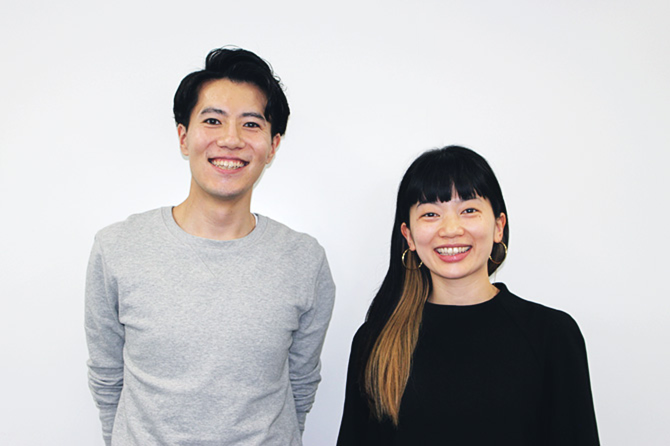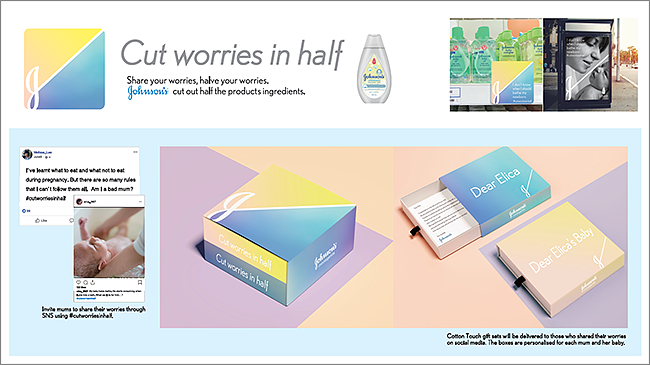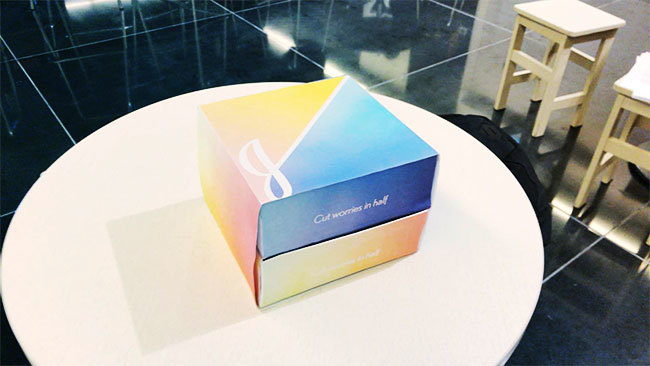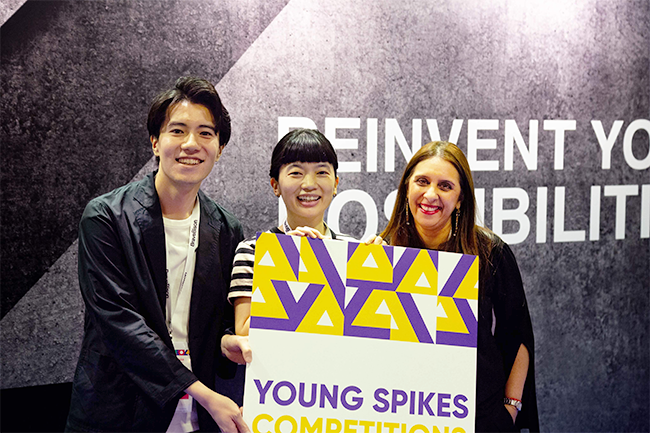Spikes Asia, held annually as Asia's largest advertising festival, includes the Young Spikes Competition. This competition is exclusively for participants under 30, with teams of two representatives from each country competing by planning and presenting solutions to a local challenge within 24 hours. It features categories such as Digital and PR, with competitions held within each category.
This year, Dentsu Inc.'s Sayuri Nakagawa (Creative Planning Division 5) and Yu Watanabe (Creative Planning Division 1) competed in the Design category and won Silver at the finals held in Singapore.
We spoke with the two about the competition's content and what they gained from the experience.

(From left) Yu Watanabe (Dentsu Inc., Creative Planning Division 1), Sayuri Nakagawa (Dentsu Inc., Creative Planning Division 5)
Half joy, half regret. But above all, it was fun.
──How do you feel now after participating in the Young Spikes Competition?
Nakagawa: I'm genuinely glad I got to be part of that event. Winning an award was great, and since I'd hardly ever had the chance to talk about advertising with people from different countries before, the networking event after the competition was really fun too. Also, since Young Spikes is a competition limited to those under 30, the participants are our peers. The opportunity to talk with creators of the same generation from different agencies was incredibly valuable and inspiring in that regard.
Watanabe: The Silver result itself is half joy, half regret (laughs). Still, it was fun. Working in Japan, you don't often get chances to talk with people from other countries. Within that context, being able to convey our ideas to people from various nations, living in completely different environments, was a huge experience.
──Why did you decide to enter as a duo this time?
Nakagawa: Watanabe and I joined the company in 2011 as colleagues. In our third year, we submitted entries to the Daily Advertising Design Awards together and won the top prize. After that, Watanabe transferred to the Chubu branch, and I spent about a year and a half studying abroad in the UK. But since we both just returned to Tokyo, we decided to take on this challenge again.
Watanabe: I spent about four years in Nagoya. At the Chubu branch, there were people like Michihito Dobashi, who had previously won a Grand Prix at Cannes Lions. Influenced by them, I also developed a desire to participate in international competitions.
Nakagawa: Within our department, there was a strong push for young staff to actively enter competitions, so I applied without hesitation.
"Halving Mom's Worries": The Solution the Two Presented for the Challenge
──The Design category you entered held open preliminary rounds, with 10 teams selected for the finals. What challenge was presented in the finals, and what kind of proposal did you submit?
Nakagawa: The client was JOHNSON'S, known for baby care products. The challenge was to develop a branding strategy for their new baby shampoo and baby oil products ahead of their launch. Submissions included a 10-slide presentation and creating a gift box. We had to submit our plan by the day after the challenge was announced. Then, we spent the next day creating the gift box and preparing for the presentation.
Watanabe: The judging criteria included "developing a campaign spanning online and offline channels" and "creating mechanisms that make it easier for consumers to consider purchasing." While it involved design, this time it was closer to communication design.
Nakagawa: The key feature of JOHNSON'S new product was its commitment to safety for children. To achieve this, it minimized the addition of substances that could be burdensome for children and reduced the number of ingredients used to half of previous formulations.
The target audience was millennial mothers with young children. We focused on three key insights from them: "They often feel overwhelmed by information overload online and worry excessively," "They sometimes feel pressure to present a perfect image on social media," and "They prioritize their child's safety above all else."
The brand positioned JOHNSON'S as "the brand that best understands the concerns of millennial moms" and developed a campaign centered on the "half" concept: "Share your worries on social media and let's cut mom's anxiety in half." The campaign copy was "Cut worries in half."
※Millennials: Often refers to people born from the 1980s to the early 2000s

Courtesy of Spikes Asia 2018
Watanabe: Once the concept was finalized, we created the main logo design. Using the initial "J" of JOHNSON'S as the motif, we designed it to evoke the image of a slash by interpreting the tail of the letter as a slash, creating a design that suggests halving.
Nakagawa: For the campaign, we created a system where mothers could post their worries on social media or a dedicated website with the hashtag #Cutworriesinhalf to receive a gift box. It's a campaign bridging online and offline.

Courtesy of Spikes Asia 2018

Courtesy of Spikes Asia 2018
Watanabe: Actually, about a week before the main competition, I had the chance to show Mr. Tsuchihashi another piece we'd created as independent practice, using a challenge from a past Young Cannes. At that time, he pointed out that our strength was the "clarity of our concept."
So, this time, we focused on "making our concept easy to understand." During the main competition, we repeatedly dug deep into our proposal and production concepts, deciding to compete based on "clarity" and "simplicity."
Going through this experience made me realize how important it is to clearly define our strengths. This applies to real work too. For example, when multiple ideas emerge, if we don't focus on the direction we excel at, the precision of the proposal won't improve. In that sense, I'm glad we were able to identify our strengths beforehand this time.
The joy of ideas transcending nationality and culture
──Did you feel that the "clarity of your proposal" led to the high evaluation?
Watanabe: Yes. When Nakagawa-san presented, the judges reacted with immediate understanding.
Another thing that made me happy was that the judge who gave us the highest evaluation was a woman with a 17-year-old daughter. She told us, "This really resonates with a mother's perspective." She's a different gender than me, and our positions, nationalities, and languages are different too. Yet our idea still got through to her, and that gave me tremendous confidence.
──What did you both learn through this competition?
Nakagawa: It was a great opportunity to rethink copywriting. Since the copy for this competition had to be in English, it required a different approach than Japanese. As a non-native English speaker, I focused on keeping the language simple and direct rather than relying on rhetorical flourishes.
That said, being too simple can sometimes weaken the copy... Finding that balance and exercising that consideration was a valuable lesson. I think it will be useful in future work too.
Watanabe: Working internationally, I realized how crucial it is to use expressions that resonate even with people who don't share the cultural context. In design terms, that means explaining "Why this shape?" or "Why this color?" That's a key difference from domestic work, and it was valuable to experience it firsthand this time.
──Finally, please share your future goals.
Nakagawa: When I studied abroad in the UK, I focused on gender and media. Compared to Japan, the UK is a country with a diverse range of ethnicities. That's precisely why I noticed so many advertisements addressing race and gender.
I hope to someday work on advertising that sends messages about gender, diversity, and other social issues. In that sense, this experience—presenting my ideas to people from diverse backgrounds—was invaluable. I want to continue participating in international projects and competitions.
Watanabe: What stood out most this time was conveying our ideas to people from different countries and cultural backgrounds. That experience was truly memorable, making me eager to actively challenge myself in non-verbal communication and creating work that transcends language barriers. And someday, I'd be thrilled to win an international advertising award.

At the Young Spikes Competition Design Category Awards Ceremony









